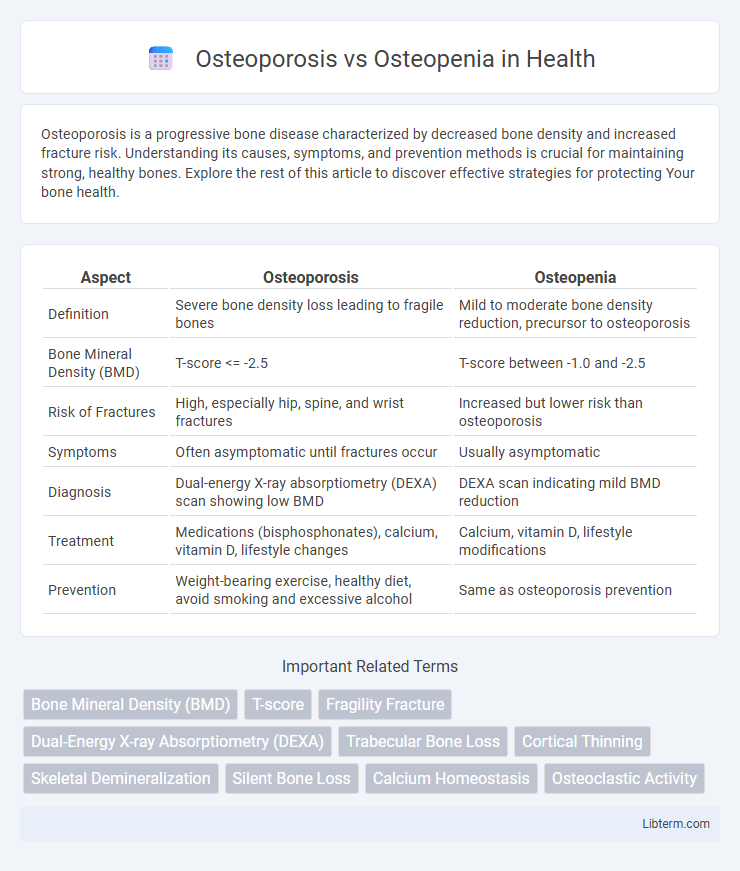Osteoporosis is a progressive bone disease characterized by decreased bone density and increased fracture risk. Understanding its causes, symptoms, and prevention methods is crucial for maintaining strong, healthy bones. Explore the rest of this article to discover effective strategies for protecting Your bone health.
Table of Comparison
| Aspect | Osteoporosis | Osteopenia |
|---|---|---|
| Definition | Severe bone density loss leading to fragile bones | Mild to moderate bone density reduction, precursor to osteoporosis |
| Bone Mineral Density (BMD) | T-score <= -2.5 | T-score between -1.0 and -2.5 |
| Risk of Fractures | High, especially hip, spine, and wrist fractures | Increased but lower risk than osteoporosis |
| Symptoms | Often asymptomatic until fractures occur | Usually asymptomatic |
| Diagnosis | Dual-energy X-ray absorptiometry (DEXA) scan showing low BMD | DEXA scan indicating mild BMD reduction |
| Treatment | Medications (bisphosphonates), calcium, vitamin D, lifestyle changes | Calcium, vitamin D, lifestyle modifications |
| Prevention | Weight-bearing exercise, healthy diet, avoid smoking and excessive alcohol | Same as osteoporosis prevention |
Understanding Osteoporosis and Osteopenia
Osteoporosis and osteopenia are conditions characterized by decreased bone density, with osteoporosis indicating a more severe loss that significantly increases fracture risk. Osteopenia represents early-stage bone loss where bone mineral density (BMD) is lower than normal but not low enough to be classified as osteoporosis, typically measured using a T-score between -1.0 and -2.5. Both conditions are diagnosed through dual-energy X-ray absorptiometry (DXA) scans, with osteoporosis defined by a T-score of -2.5 or lower, highlighting the importance of early detection for effective bone health management.
Key Differences Between Osteoporosis and Osteopenia
Osteoporosis and osteopenia both involve reduced bone density, but osteoporosis represents a more severe loss, increasing fracture risk significantly. Bone Mineral Density (BMD) scores differentiate the conditions: osteopenia falls between -1.0 and -2.5 standard deviations below the young adult mean, while osteoporosis is characterized by a BMD score lower than -2.5. Clinical management varies since osteoporosis typically requires more aggressive treatment to prevent fractures, whereas osteopenia often involves lifestyle modifications and monitoring.
Causes and Risk Factors
Osteoporosis and osteopenia both result from decreased bone density, primarily caused by aging, hormonal changes such as estrogen deficiency in postmenopausal women, and insufficient calcium or vitamin D intake. Risk factors include genetic predisposition, sedentary lifestyle, smoking, excessive alcohol consumption, and certain medications like corticosteroids. Osteoporosis represents a more advanced stage of bone loss with a higher fracture risk compared to osteopenia, which is considered a precursor condition.
Signs and Symptoms to Watch For
Osteoporosis and osteopenia both involve decreased bone density, but osteoporosis presents more severe bone loss, increasing fracture risk significantly. Common signs to watch for include sudden fractures, back pain caused by vertebral collapse, and a noticeable decrease in height or a stooped posture. Early symptoms of osteopenia are often subtle or absent, making bone density testing essential for timely diagnosis and prevention of progression to osteoporosis.
Diagnostic Criteria and Screening Methods
Osteoporosis is diagnosed when bone mineral density (BMD) T-score is <= -2.5, while osteopenia is defined by a T-score between -1.0 and -2.5, based on dual-energy X-ray absorptiometry (DXA) measurements. Screening methods include DXA scans at the hip and lumbar spine, recommended for postmenopausal women and men over 70 or younger individuals with risk factors. FRAX tool complements diagnostic criteria by estimating 10-year fracture risk to guide treatment decisions.
Impact on Bone Health and Fracture Risk
Osteoporosis severely weakens bone density, significantly increasing the risk of fractures, especially in the hip, spine, and wrist. Osteopenia represents a milder reduction in bone mineral density, indicating a higher risk of bone loss progression and fracture than normal bone health but lower than osteoporosis. Both conditions impair bone strength, with osteoporosis posing the greatest threat to skeletal integrity and long-term mobility.
Treatment Options for Osteoporosis vs Osteopenia
Treatment options for osteoporosis primarily involve bisphosphonates such as alendronate and risedronate, calcium and vitamin D supplementation, and lifestyle changes like weight-bearing exercise to enhance bone density and reduce fracture risk. Osteopenia management focuses on lifestyle modification, including increased calcium intake, regular physical activity, smoking cessation, and monitoring bone mineral density to prevent progression to osteoporosis. In severe cases of osteopenia with high fracture risk, clinicians may consider pharmacologic interventions similar to osteoporosis treatment to strengthen bone health.
Lifestyle Changes and Prevention Strategies
Osteoporosis and osteopenia require targeted lifestyle changes to strengthen bone density and reduce fracture risk. A diet rich in calcium (1,000-1,200 mg daily) and vitamin D (800-1,000 IU daily), combined with weight-bearing exercises like walking or resistance training, enhances bone health. Avoiding smoking and excessive alcohol intake further supports bone maintenance and prevents progression from osteopenia to osteoporosis.
Managing Complications and Improving Quality of Life
Effective management of osteoporosis and osteopenia involves targeted interventions to reduce fracture risk, including pharmacologic treatments such as bisphosphonates for osteoporosis and lifestyle modifications like weight-bearing exercise and calcium supplementation for both conditions. Addressing complications requires regular bone density monitoring, fall prevention strategies, and physical therapy to enhance mobility and strength. Improving quality of life centers on patient education, nutritional optimization, and adherence to treatment plans to maintain bone health and minimize disability.
Frequently Asked Questions about Osteoporosis and Osteopenia
Osteoporosis and osteopenia differ primarily in bone density severity, with osteoporosis indicating more advanced bone loss and higher fracture risk. Common questions address diagnosis methods, such as dual-energy X-ray absorptiometry (DEXA) scans, and treatment options including calcium, vitamin D supplementation, and medications like bisphosphonates. Prevention strategies focus on lifestyle changes like weight-bearing exercise and smoking cessation to maintain optimal bone health.
Osteoporosis Infographic

 libterm.com
libterm.com